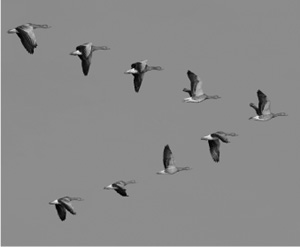Animal BehaviorBehavioral Ecology |
Why do birds fly in formation? |
Some birds, like Canadian geese and whooping cranes, often fly in V-formation because of the phenomenon called wingtip vortices. The lead bird in the V-formation “breaks up” the wall of air that the flock flies into; the swirling air then helps push along the birds behind. However, being the lead bird is hard work, and the leader may then drop back to allow another bird to take on the work of the lead bird. The V-formation also gives these birds the ability to watch each other and communicate (via honking) about likely landing spots.

Migratory birds like these geese fly in a V-shaped formation in order to reduce drag and conserve energy.
